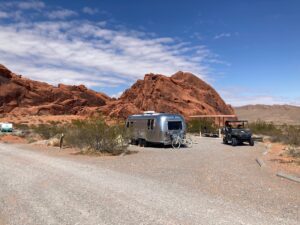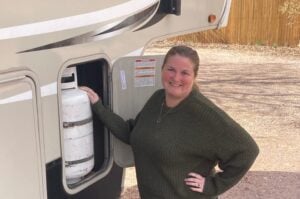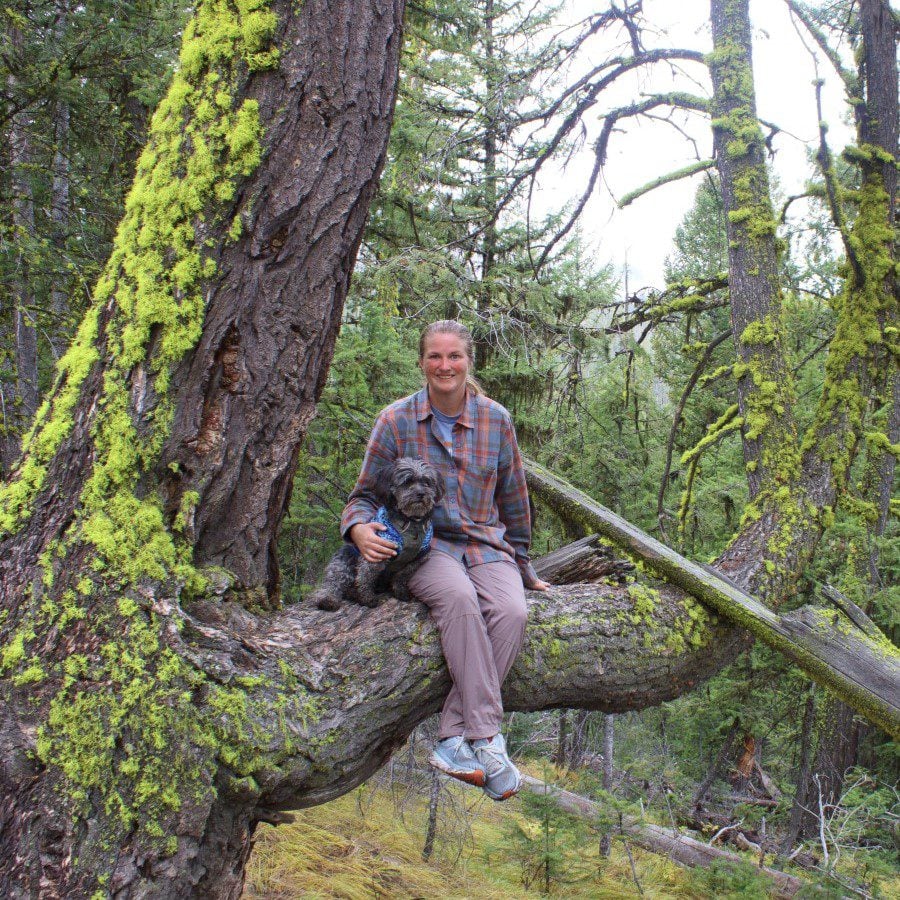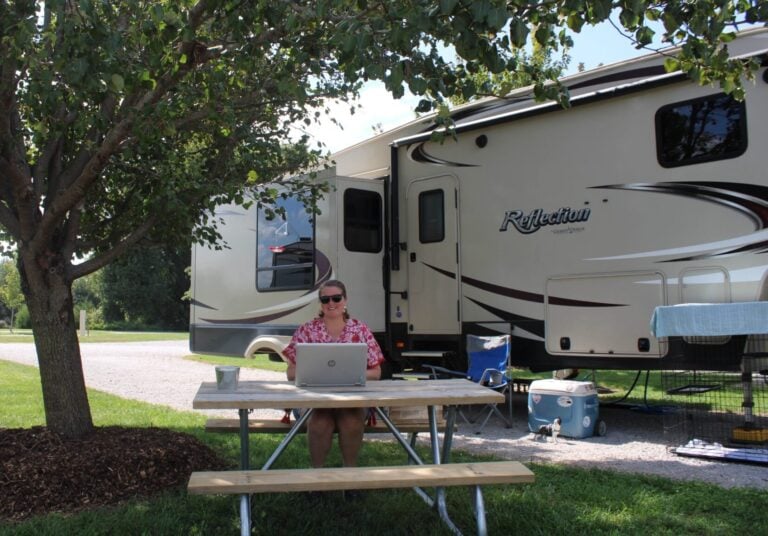This post may contain affiliate links. See our affiliate disclaimer here.
What is the true monthly cost of living in an RV? The answer varies greatly based on the type of RV lifestyle you chose. If you plan to boondock full-time and cook all of your meals, you can live very cheaply in an RV. On the other hand, if you stay at fancy resorts and eat out regularly, the cost of RV living could be more expensive than your stationary lifestyle.
Below, I outline all of the potential costs associated with RV living so you can calculate your own required budget. To make the process even easier, I have created an RV Living Cost Calculator so you can easily add-up your annual full-time RV budget. If you are considering moving into an RV, also check out my complete list of pros and cons of RV Living.
Contents
Rent and Vehicle Costs
When calculating the monthly cost of living in an RV, the largest expenses you will incur as a full-time RVer are your vehicles and places to park them.
Campground Rent

Personally, the fee for campsites is currently our largest expense in our monthly cost of living in an RV. It is also the most variable expense among RVers. Many RVers pursuing cheaper expenses, boondock for free, while others pay up to $2000 a month to stay at resorts in great locations.
Most private RV parks charge at least $40 per night, while state parks and COE campgrounds offer more affordable RV site. We personally budget an average of $800 per month for rent. The actual amount we pay in rent varies by month, but typically ranges from $400 to $1500.
If you are going to boondock, there will not be any rent, but you should consider the other expenses that may be required. These could include dumping fees ($5-$10 per dump), a composting toilet (around $1000) and generators or solar panels ($1000 or more). I also count any membership club fees into our rent budget.
RV and Truck Maintenance
Again, this expense varies greatly depending on the age and type of your RV. We personally budget $250 per month ($3000 per year) for regular service and unexpected repairs. When not used, our monthly repair budget is put into our savings account. When calculating the monthly cost of RV living, include an annual inspection and an absolute minimum of $2000 for unexpected repairs. I recommend budgeting more in the first year or two, and then this line item can be reduced if you have built savings.
You also need to budget for lodging costs. When your home on wheels is in the shop for repairs, you will need somewhere to sleep. We always schedule our annual service when we can stay with friends or family. Still, we typically stay in a hotel 1 to 2 nights each year when unexpected repairs are required. We also try to limit our repair expenses by always trying to complete repairs ourselves before calling taking it to a shop.
RV and Tow Vehicle Payments

If you financed your RV and/or tow vehicle, you will need to include these payments in your monthly RV living budget. Ideally, you would put as large of a down payment as possible to lower your monthly cost of living in an RV. We sold our house and the majority of our possessions, which allowed us pay off our RV loan quickly.
Use our RV loan calculator to estimate your monthly payment.
RV and Tow Vehicle Insurance
We currently pay $110 monthly for a plan, that covers our fifth wheel and truck. I highly recommend shopping around before choosing an insurance plan, as the company who offered you the best price for homeowners or renters insurance does not necessarily have the best plan for you new coverage needs. Personally, Amica was the most affordable option for us when I compared prices last in early 2021. Your tow vehicle insurance often covers your fifth wheel or travel trailer while driving, so make sure you don’t pay extra for collision insurance on the trailer.
RV and Tow Vehicle Registration and Taxes
We currently pay about $700 per year for registration, as the taxes for a diesel truck are high in our home state. You can limit this expense if you establish domicile in a state with lower taxes and fees.
Fuel

Diesel for our tow truck currently costs us between $500 to $1000 per month. The cost varies greatly depending on where we are in the country and how much we are traveling. When setting a fuel budget, over-estimate costs as there is always a chance prices will rise. Use our RV Fuel Cost Calculator to help accurately determine your monthly fuel costs.
Monthly Cost of RV Living
In addition to the major expenses that contribute to the monthly cost of living in an RV, there are also several small items to account for.
Propane

You will need propane for heat and cooking in your RV. The average price to refill our 20 pound tank is typically around $20. We tend to stay in warmer climates, so we only budget for a single refill each month. Budget for multiple refills, if you will be using the heat regularly. Click here to see current average propane prices by state.
Laundry
We don’t have a washer/dryer in our RV, so we do all of our laundry at RV parks or laundromats. It typically costs $2 to $4 per load and we do about two loads per week for a monthly costs of about $25. If you have kids, you probably want to budget more for laundry.
Mail and Postage

If you sign-up for a mailing forwarding service, you should expect to spend about $15-$30 per month when you take into account the annual fees and additional postage costs.
RV Supplies
You will need to buy new water filters and blank tank sanitizer every 2 to 3 months, so budget about $20 a month for these expenses. See our list of absolutely essential RV camping supplies for more details.
Storage Units

I would highly discourage taking on this expense. The majority of full-time RVers who have a storage unit, regret renting one. If you do decide to rent a storage unit, the typical cost is $50-$200 per month depending on the size. Read our article on downsizing for RV living for more thoughts on what is worth storing.
Mobile Internet
If you work from a computer, the easiest way to connect is to buy a mobile hotspot. I currently pay about $150 per month to Verizon for a 30GB data plan for my phone and hotspot. 30GB is just enough data to allow me to work 45 hours a week from the computer. For more options, read our RV internet guide.
Experiences

You don’t move into an RV to sit around the campsite, so you will need an exploration budget. Of course, the will vary depending on your hobbies and interests. Personally, we budget about $100 a month for outdoor activities like state park fees and kayak rentals. We also budget a bit more for eating out than we did in our stationary home as there are cool, new restaurants and bars to try at every destination.
We love live music and we have attended significantly more concerts since moving into the RV, so we devote a good portion of our experiences and entertainment budget to these events. When setting your budget, think about what your must have experiences are at each destination and budget accordingly. If you spend more on live entertainment one month, cut the restaurant budget back to help stay on track.
Health Insurance
Health insurance is a major expense for most full-time RVers, especially those who are self-employed. Learn about health insurance options for full-time travelers, and research your premium and deductible options before creating an RV living budget.
Standard Monthly Cost of Living in an RV
There are several common expenses including groceries, clothing, pet supplies and personal care that I have not included in the monthly cost of living in an RV. Overall, we have found that these expenses are no different for a nomad than they would be for anyone else.
Look at what you spend now, and budget the same amount unless you have made a real commitment to cut back in certain areas like clothing. If you are planning to reduce everyday costs, test yourself before moving into the RV to ensure you are being realistic.
Expenses to Remove from your Budget

Once you’ve added everything up and calculated the monthly cost of living in an RV, you will quickly realize that full-time RVing isn’t necessarily cheap. The good news is there are also several expenses from your stationary life that you no longer need to pay. These include:
- Utilities: Electricity and water are typically included in your campsite rent.
- Cable: Some RVers do purchase satellite dishes and plans, but you can use your RV’s antenna to get free TV. Read our article on RV TV options for more detail.
- Stuff: When you live in a tiny space, you can’t buy cute stuff from Target every time you go shopping. Plan to reduce your décor, fashion and impulse purchases when living in an RV.
- Mortgage, Property Taxes and Home Insurance: If you owned a home before moving into the RV, you can expect to pay less in taxes, insurance and repairs than typically required for a house.
The monthly cost of living in an RV varies as much as the budgets of people in any community. The important things are to be prepared and be realistic.
Consider how much money you will bring in each month and how much are willing to cut back on expenditures. Knowing your finances are in order will allow you to relax and enjoy your new lifestyle. Also, checkout our 10 tips for cheap RV living.
Comment below if you have any other questions about the monthly cost of living in a RV.

Christina Pate is a seasoned full-time RVer who, along with her husband Justin, has journeyed across the US, Canada, and Mexico. Drawing from her extensive travels, RV repairs and RV renovations, she founded Travels with Ted to guide and inspire fellow RV enthusiasts. Christina is also the co-author of The Owner’s Guide to RV Maintenance and the creator of My RV Log Book.

